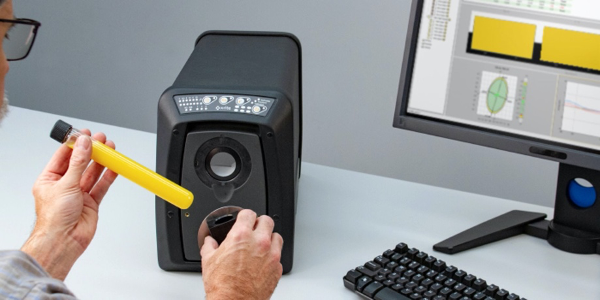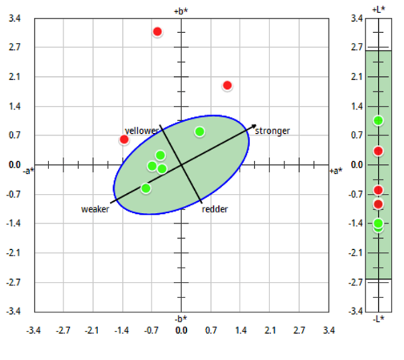El color de los líquidos es uno de los aspectos más difíciles de controlar durante la producción. Pero es crucial. ¿Elegirías un jugo o limpiador que sea más claro que los demás frascos en la estantería? ¿Y qué pasa con el jarabe para la tos?

Los líquidos son difíciles de medir debido a su transparencia, que varía de translúcido a opaco. Además, es difícil sostenerlos y el dispositivo de medición no puede tocar el líquido, o de lo contrario, la óptica y la muestra se contaminarán.
El blog de hoy explica cómo elegir el espectrofotómetro adecuado para medir líquidos, cómo presentar una muestra líquida y qué hacer con los datos después de la medición.
Eligiendo un Dispositivo para Medición de Color Líquido
Al elegir un espectrofotómetro, la composición química del líquido es menos importante que la transparencia. Por ejemplo, el jugo de manzana es claro y mayormente translúcido, permitiendo que la luz pase fácilmente. La sidra de manzana es opaca por la pulpa, y el puré casi totalmente opaco. Aunque todos estos productos están hechos de manzanas, el color de cada uno se mide de manera diferente.

La cerveza es otro ejemplo. Una cerveza oscura se medirá de manera diferente a una cerveza clara y transparente.

Esta lógica también se aplica a colorantes líquidos, productos químicos y soluciones de limpieza. Un limpiador de vidrios líquido azul claro se medirá de manera diferente a un detergente azul opaco.
La conclusión es que la composición química del líquido no es importante. Para determinar cómo medir un líquido, debes considerar la opacidad y la translucidez.
Medición de un Líquido con Opacidad
Los líquidos opacos no permiten que la luz pase completamente, por lo que deben medirse en modo de reflectancia. El dispositivo emite una luz en la muestra y registra el tipo y el porcentaje de luz reflejada.
Espectrofotómetro de Mesa de Esfera Ci7000
Aquí el Ci7520 está equipado con un soporte para tubo de ensayo para medir jugo de naranja. El soporte se ajusta en la placa de apertura de un Ci7000 y posiciona el tubo de ensayo en la posición correcta para la colorimetría de reflectancia del líquido. Dado que la mayoría de los líquidos no son completamente opacos, el fondo desempeñará un papel en el color final. Este soporte tiene un marco negro, pero X-Rite también fabrica uno con marco blanco.

Todos los modelos de la série Ci7000 miden en ambos modos de reflectancia y transmisión, excepto los Ci7500 y Ci7520, que solo miden en modo de reflectancia. Esto los convierte en una opción económica para laboratorios que no necesitan medir líquidos translúcidos.
Espectrofotómetro de Imágenes MetaVue VS3200

Para medir líquidos más espesos como puré de manzana, el MetaVue VS3200 puede medir líquidos, pastas y geles, así como otros artículos no líquidos como polvos y elementos no planos.
El MetaVue VS3200 puede ser equipado con un soporte y diferentes tipos de bandejas para sujetar la muestra. Las bandejas se deslizan en el soporte del instrumento debajo del dispositivo para posicionar la muestra para medición de reflectancia.

Como es un instrumento sin contacto, no hay riesgo de contaminación para la muestra o el dispositivo.
Medición de un Líquido con Transparencia
Como la luz pasa a través de un líquido transparente, debe medirse en modo de transmisión. El espectrofotómetro emite una luz a través de la muestra y mide el tipo y la cantidad de luz que pasa.
El Ci7600 puede medir en modo de reflectancia, pero también tiene una puerta superior que se desliza para permitir mediciones de transmisión. Está sosteniendo una cubeta de vidrio cuadrada que encaja en el Kit de Transmisión de la Serie Ci7000 y se sella sobre la apertura de medición.

Cómo Utilizar Datos de Medición de Color Líquido
Cada medición captura el tipo y el porcentaje de luz que pasa o refleja en la muestra. Cuando se ingresan en un programa de control de calidad como Color iQC, estos datos pueden proporcionar información sobre el color y la transparencia del líquido. Estos datos funcionan de la misma manera para mediciones de reflectancia y transmisión.
Datos de Aprobación/Reprobación
Al utilizar métricas y tolerancias de color estándar CIE, el software de control de calidad puede trazar dónde se encuentra cada muestra en comparación con el estándar e indicar si está dentro de la tolerancia definida. Estos datos ayudan a determinar qué añadir o restar en la receta para ajustar el color y cumplir con la tolerancia.

Datos de Índice
 El software de control de calidad también puede determinar si una medición cumple con un índice específico, como el Índice de Jugo de Naranja, para obtener una clasificación USDA. Otros productos como químicos también se clasifican. Una clasificación más alta tiene un valor mayor, lo que hace importante medir el color del líquido para determinar precios precisos.
El software de control de calidad también puede determinar si una medición cumple con un índice específico, como el Índice de Jugo de Naranja, para obtener una clasificación USDA. Otros productos como químicos también se clasifican. Una clasificación más alta tiene un valor mayor, lo que hace importante medir el color del líquido para determinar precios precisos.
A veces, los datos se pueden usar para ajustar la receta, y a veces no. Por ejemplo, si es un producto natural como un jugo de fruta o vegetal, el espectrofotómetro está midiendo lo que la receta creó utilizando ingredientes crudos como naranjas o tomates. No se pueden usar aditivos para ajustar el color final, pero los resultados aún ayudan a clasificar el producto.
Los modelos Ci7520 y Ci7600, junto con el software Color iQC están aprobados por la USDA para la clasificación del color del jugo de naranja. Esta solución calcula puntuaciones de color para jugos de naranja congelados, concentrados, pasteurizados y enlatados para proporcionar resultados verificados y obtener un sello de grado USDA. Obtén más información en nuestro blog Fresh Perspective on Orange Juice Color.
Datos de Claridad
Un espectrofotómetro también puede cuantificar la claridad de un líquido. Volviendo al ejemplo del jugo de manzana, si la medición de transmisión muestra que no pasa suficiente luz, el jugo puede necesitar ser filtrado. Lo mismo puede ser cierto para otros líquidos como productos químicos y colorantes.
¿Qué Dispositivo es Adecuado para Sus Necesidades de Medición de Color Líquido?
Para saber más, consulta estos webinars a demanda:
- Cómo Medir Muestras Únicas
- Mejores Prácticas para Medir el Color de Jugo de Naranja y Otros Líquidos
Si aún tienes dudas o preguntas sobre tu aplicación específica, contáctanos. Estamos encantados de ayudarte a elegir el mejor dispositivo para tus necesidades.
